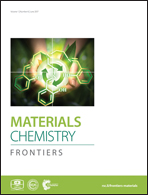One-pot synthesis of zinc doped yttrium copper titanate by semi-wet route exhibiting enhanced dielectric constant and suppressed dielectric loss
Abstract
Powder of Y2/3Cu2.90Zn0.10Ti4O12 (YCZTO) ceramic with particle size ranging from 39 ± 6 nm was grown for the first time by the semi-wet route. The intrinsic dielectric property of this unusual cubic perovskite ceramic was rationalized simultaneously with the help of dielectric, impedance and modulus spectroscopic measurements. A logical correlation of the dependence of dielectric properties on the microstructure of YCZTO ceramic was investigated. TG/DTA, XRD, SEM, and TEM were employed to disclose its microstructural details. YCZTO ceramic exhibits a high dielectric constant (εr ∼1.85 × 104) at 308 K, which rises on cooling without any signature of structural transition. Dielectric loss (tan δ) decreases exponentially with increases in temperature owing to the thermally activated grain boundary electrical conduction. Grain and grain boundary resistance of YCZTO ceramic at room temperature was found to be 347 Ω and 1.70 MΩ, respectively. The grain boundary resistance decreases with temperature while grain resistance is almost independent of temperature. The magnetic study confirms the presence of paramagnetic to superparamagnetic phase transition in the ceramic.


 Please wait while we load your content...
Please wait while we load your content...